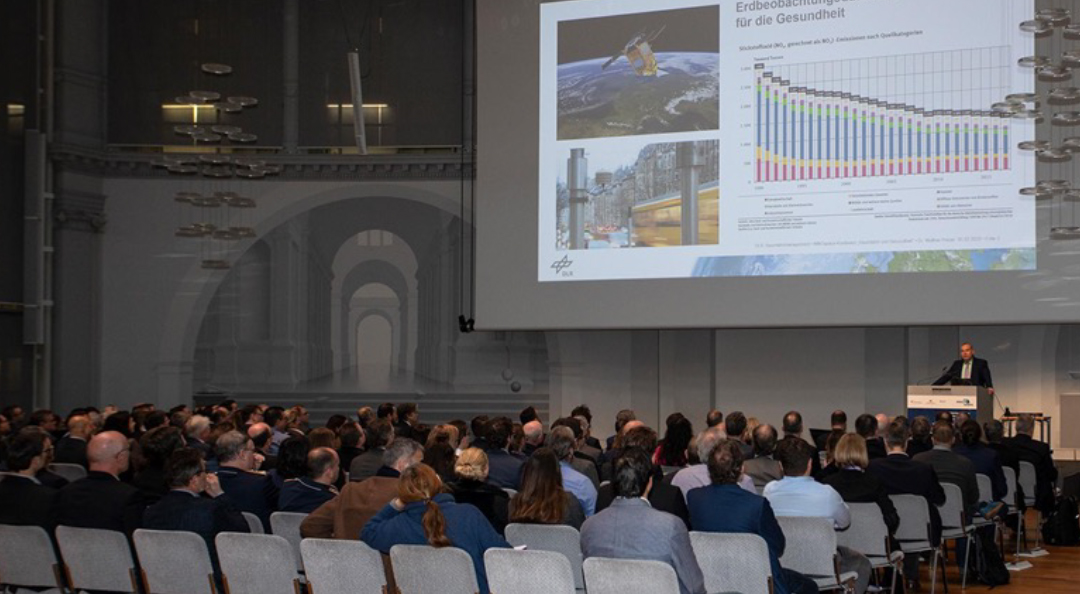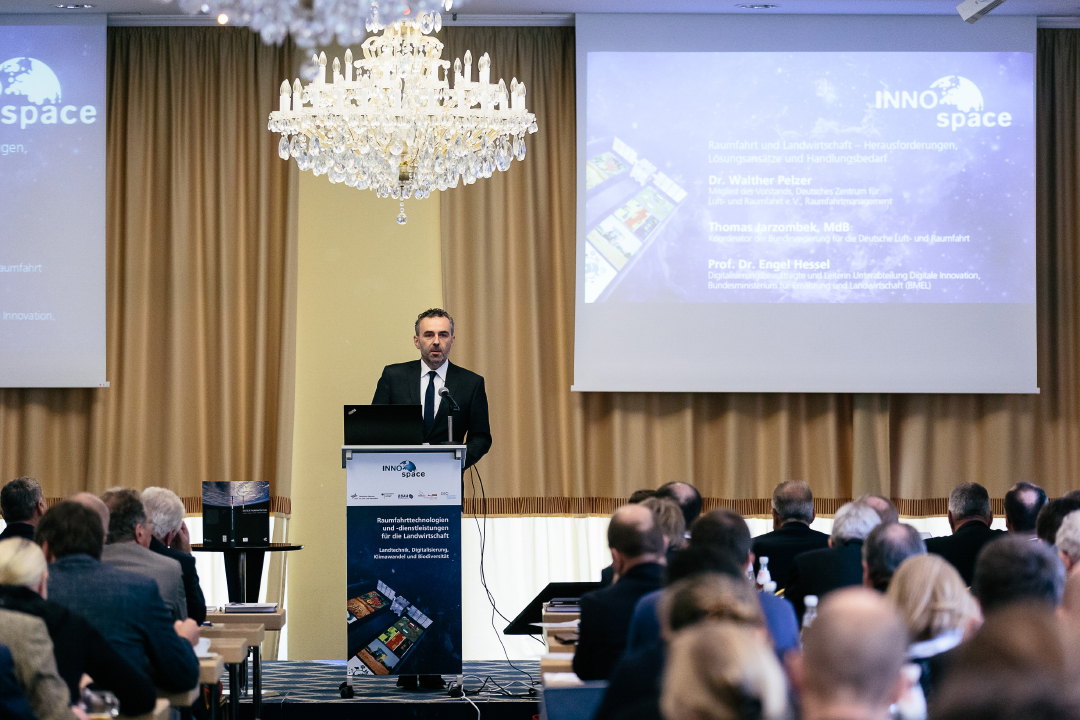INNOspace® – an initiative of
the German Space Agency
at DLR for fostering innovations
and new markets
How do new products and technologies emerge from inventions pointing the way to the future? How do developments and innovations from space flight find their way to other economic sectors and fields of application? How can the space flight sector learn from inventions in other industrial sectors? By information, communication, and cooperation.
The INNOspace® initiative of the German Space Agency at DLR aims to create stimuli for innovation and technology transfers between space flight and other economic sectors. The exchange of know-how and technologies is intended to be bidirectional. Thus, multiplier effects will help to tap new markets and to create economic added value in downstream markets and outside the space sector.
Activities of the German Space Agency’s INNOspace® initiative:
- Cross-sector symposiums to initiate cooperation projects
- Innovation competition INNOspace® Masters in cooperation with the German ESA Business Incubation Centres, Airbus, OHB, and Mercedes-Benz AG
- Technology cooperation networks Space2Motion, Space2Agriculture, and Space2Health
- Expert and user workshops for tapping new markets
- Funding of innovation and transfer projects with funds from the National Programme for Space and Innovation
- Mobile exhibition INNOspaceEXPO “All.täglich!” for presenting everyday applications deriving from space flight with public appeal
The activities take place in close cooperation with the Federal Ministry for Economic Affairs and Climate Action as well as several German federal states.

Innovation in the focus of politics
The Space Strategy of the Federal Government 2010
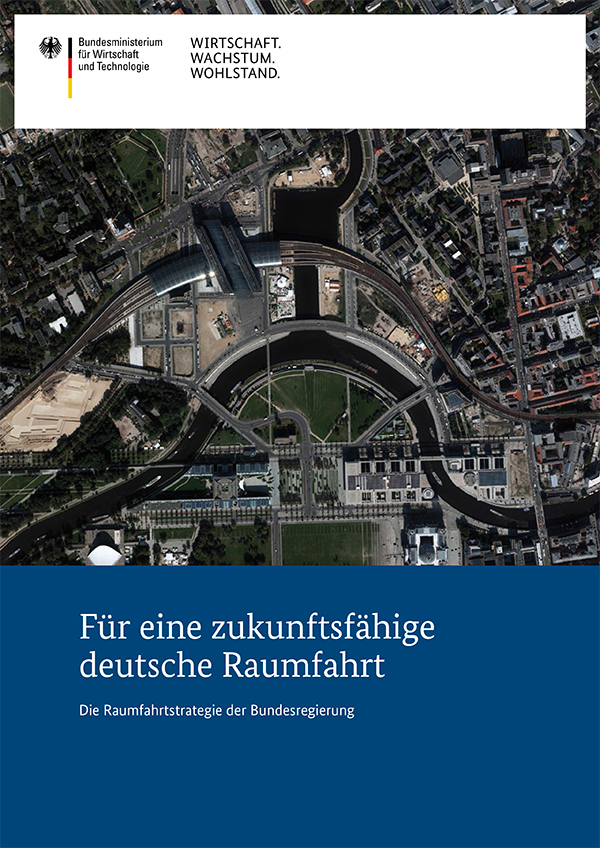 Making the German space sector fit for the future – the Space Strategy of the Federal Government 2010.
Making the German space sector fit for the future – the Space Strategy of the Federal Government 2010.
One of the guiding principles of the Federal Government’s Space Strategy 2010 is “Into space for the benefit of humankind”. Besides powerful research, it emphasises the clear orientation of space flight towards benefits and needs. Moreover, a stronger commitment of the private industry and new business models are requested that open up the commercial potential of space technologies on a broader investment basis.
With this assignment, the German Space Agency at DLR started an initiative of its own in 2013 for fostering innovation, technology transfer, and new markets – the INNOspace® initiative.
The new High-Tech Strategy 2025 of the Federal Government
Making use of key technology potentials for the economy

With the High-Tech Strategy 2025 of the Federal Government, effects are supposed to emerge from knowledge – in close cooperation between science, economy, society, and politics. Only with excellent research and efficient transfer of ideas, insights, and results to applications we can succeed in finding creative answers to the big societal challenges to strengthen the economy and to enhance quality of life, team spirit, prosperity, and growth.
Digital transformation and convergence of technologies noticeably change our working and living environment. Implementing artificial intelligence (AI) in applications, making the opportunities arising from space flight accessible for humans, intelligent design of materials or efficient use of resources – these examples give an insight into the goals of the strategy and show which areas of research and development will be supported. In order to foster spin-off and spin-in effects, the INNOspace® initiative brings together space flight stakeholders and other lines of business, thus promoting technology transfer.
Cross-sector INNOspace® symposiums
Bringing together science and industry from space flight and other industrial sectors – this is what INNOspace® symposiums aim at. Problems and approaches to solutions in different industrial sectors are introduced and discussed.
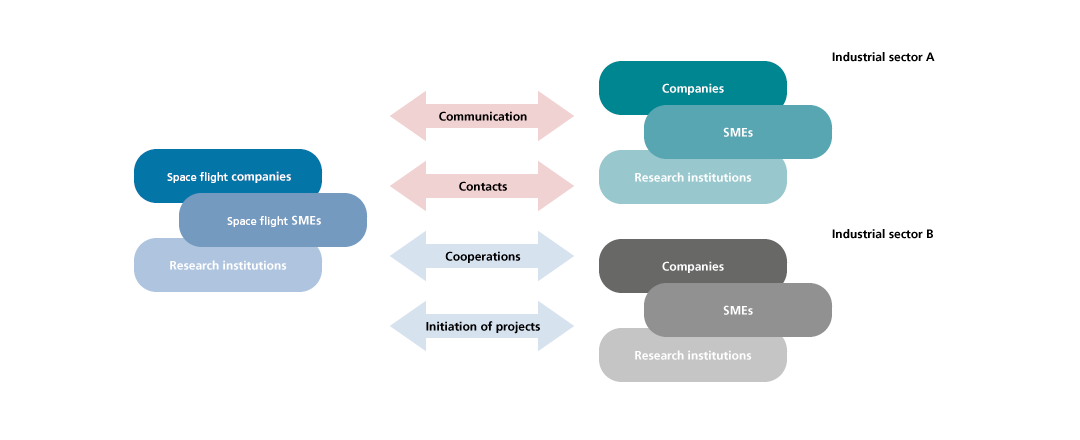
The events are performed in different federal states in close cooperation with the Federal Ministry for Economic Affairs and Climate Action, the ministries of the federal states as well as regional stakeholders such as associations and clusters.
Previous symposiums
INNOspace® workshops “New markets”
Industry in dialogue: shaping the future with space flight, Bonn, February 12, 2019
New materials, multifunctional materials, data from Earth observation satellites: many solutions found for space flight have the potential to be transferred to other, non-space areas of application. This opens up manifold opportunities for companies from various lines of business to develop and bring to market advanced products and processes – such as high-performance cast parts or better planning of cable routes with the help of soil data delivered by Earth observation. These transfer potentials were in the focus of the evening event on the premises of the German Museum in Bonn on February 12, 2019. The Chamber of Industry and Commerce Bonn/Rhein-Sieg, the German Space Agency at DLR, and the German Museum Bonn jointly invited to this event.
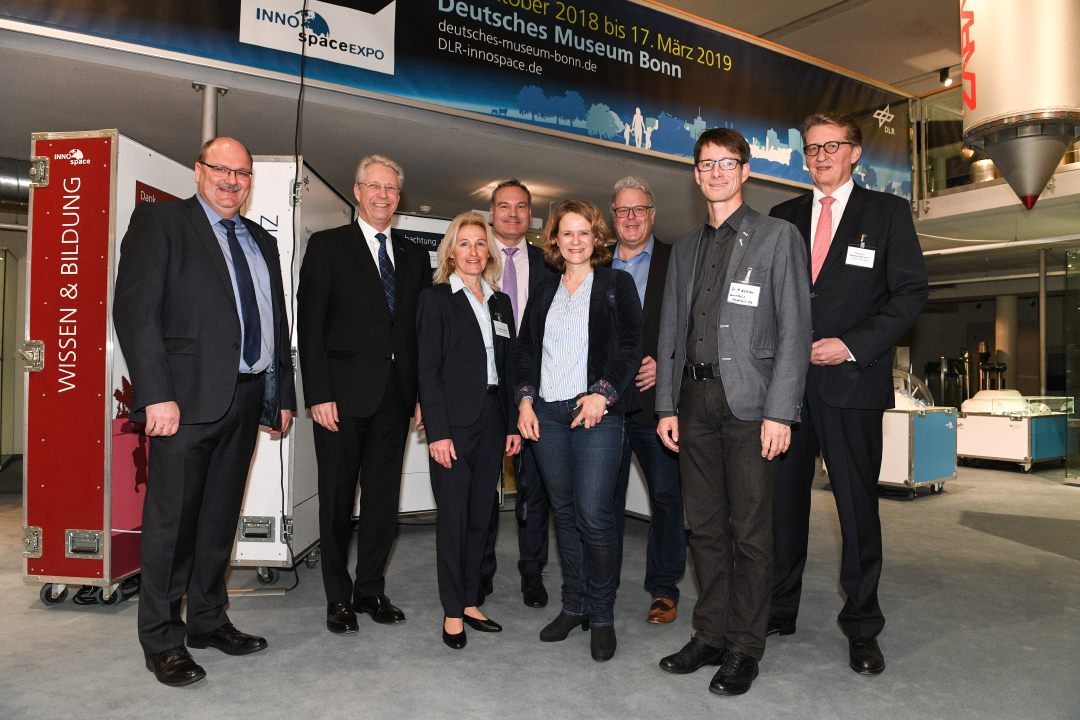
© DLR
Joint innovation workshop: DB Netz AG and German Space Agency at DLR, Bonn, June 25, 2019
In search of innovative solutions for a strong rail network of the future, DB Netz AG also relied on know-how from the space sector. They are a partner of the innovation competition INNOspace® Masters. In various workshops, the innovation team of DB Netz AG as well as several other companies had discussions at the German Space Agency at DLR about which technologies and services from space technology and satellite-based services could help shape the rail network of the future. The highest potentials were identified in the fields of Earth observation, satellite communication, and navigation, for instance, to enable an area-covering condition monitoring of real estate or catenaries via remote diagnosis from space. Earth observation data may as well be meaningful when it comes to the early prognosis or prevention of influences caused by weather such as storm damages through falling trees. Moreover, exact position determinations through global satellite navigation systems are a vital component for automated trains or the management of containers and individual waggons. Internet connections from space could also support stable WLAN in trains or the data connection of peripheral IoT sensors.
The innovation competition INNOspace® Masters
New ideas for the next space flight generation
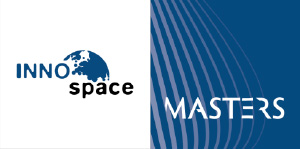 Since 2015, the German Space Agency at DLR has been hosting the annual innovation competition INNOspace® Masters. The competition is embedded in the INNOspace® initiative.
Since 2015, the German Space Agency at DLR has been hosting the annual innovation competition INNOspace® Masters. The competition is embedded in the INNOspace® initiative.
The objective of INNOspace® Masters is to initiate innovation projects based on mutual transfer between the space sector and other lines of business. The submitted project ideas are intended to transfer know-how from other business sectors to space flight (spin-in) or enable innovative terrestrial applications through space technologies and services (spin-off). Key subjects are, among others, resource-saving approaches, digital sustainability, cost efficiency, and connectivity.
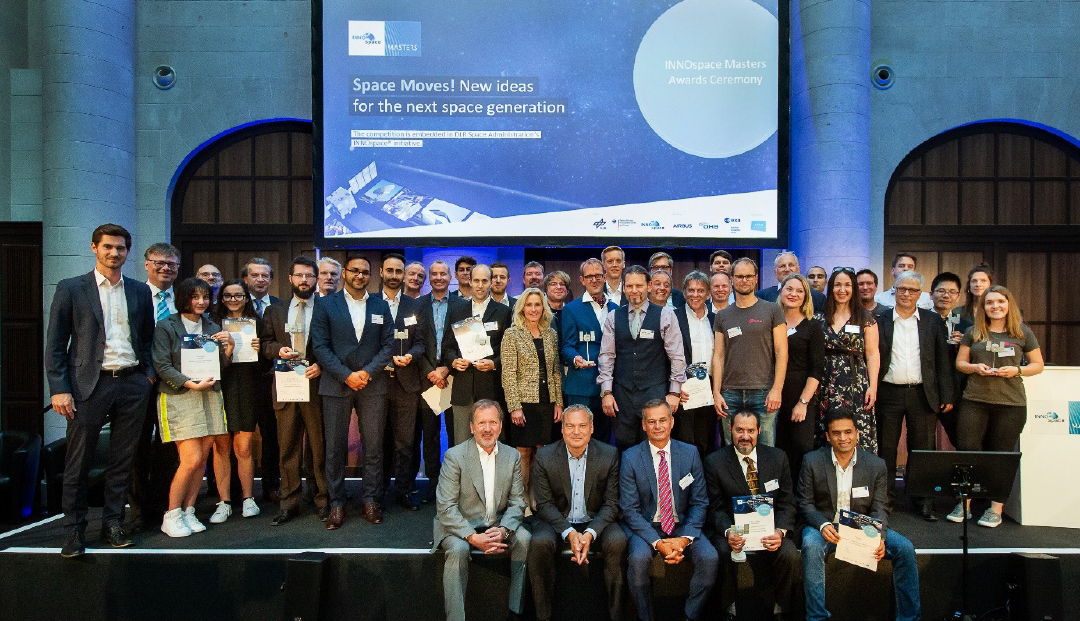
© DLR
Partners of INNOspace® Masters are the German ESA Business Incubation Centres, Airbus, OHB, and DB Netz AG. With five different challenges, oriented at the partners of the contest, all stages of the innovation process are represented, and various key issues are addressed: from R&D projects to marketable solutions. The winners of the challenges receive consulting services, cooperation opportunities as well as prize money and support funds of up to 400,000 euros per winning team to enable them to sustainably implement their ideas.
http://www.innospace-masters.de

Fostering innovation and transfer projects in space flight
A basic prerequisite for the international competitiveness of Germany as a scientific and economic business location is research on and development of innovative products and services. As a key technology, space flight makes a substantial contribution towards this goal, also for terrestrial applications and other industrial sectors.
One of the tasks of the German Space Agency at DLR is fostering innovation as well as technology and know-how transfers between space flight and other industrial sectors.
Undertakings and projects are supported with funds provided by the Federal Ministry for Economic Affairs and Climate Action (BMWK) on the basis of a decision by the German Bundestag within the “National Programme for Space and Innovation”.
The primary focus is on the following areas:
- Space flight and energy (generation, storage, and renewable energies)
- Space flight and automotive engineering, machinery and plant engineering, logistics, and traffic
- Space flight and health, medical technology, and telematics
- Space flight and software engineering, IT, and applications
- Space flight developments in the fields of robotics
- Space flight and climate or environment protection, agriculture, and disaster management

Making Germany’s space sector
fit for the future –
The Space Strategy
of the German Federal
Government
To space for the benefit of humankind, not for the sake of celebrity
Previously, space flight has been a symbol for technological footrace and the competition of the political systems between East and West. Today, it has become an integral part of our daily lives and an indispensable instrument for economy, science, and politics.
 Making Germany’s space sector fit for the future – The Space Strategy of the German Federal Government 2010
Making Germany’s space sector fit for the future – The Space Strategy of the German Federal Government 2010
Targeted fostering of key technologies
Space flight ranks among the key technologies of our modern knowledge-based society. With the space strategy adopted in 2010, the Federal Government emphasises the high significance of these technologies for Germany’s future. In the focus is the benefit of space flight for humans on Earth ‒ for the society. The Federal Government invests an annual amount of over 1 billion euros in space flight, making it the sixth-highest national budget worldwide. Through targeted fostering of national competences, Germany has been able to conquer technological top positions during the last years. Simultaneously, space flight is increasingly developing towards a dynamic business sector opening up new opportunities for the German industry
as well – in particular for SMEs. At present, a new market showing remarkable growth rates is emerging worldwide.
The funding criteria
Space projects are judged according to the contribution they make to solve the global challenges facing society.
The German Space Agency at DLR plans the German space flight programme on behalf of the Federal Government based on the Space Strategy, implements the programme, and integrates all German space flight activities at the national and European level.
Expanding strategic space flight expertise
Establishing, expanding, and maintaining system capabilities and technological superiority in selected key or pace-setting technologies.
Establishing a unified legal framework
Here, the focus is on finding and agreeing upon national and international regulations that ensure highest possible planning security and enable a regulated competition.
Sustainably expanding the strong position in space research
Basic research often acts on the boundaries of what is technically feasible and thus becomes a driver for technological top performance time and again.
Tapping new markets
As an “enabling technology”, space flight has significant economic effects. It provides infrastructures rendering possible new added-value chains in other economic sectors, in particular with downstream added-value services.
Exploiting space flight for civil and military security purposes
Satellite data and services make a vital contribution, notably to disaster relief and management, environmental and climate protection, to warning of threats, development aid, border monitoring, and arms control.
Shaping the distribution of roles in the European space sector
In the field of space policy, the guiding criterion for the distribution of work among institutions must remain the preservation of the overall performance of the European space sector. Duplicate structures must be avoided and expenditure on coordination and administration kept within limits.
Defining the roles of Germany and Europe in exploration
Exploration missions must serve a clear scientific purpose, such as basic research into the origin of the solar system or into key technologies like robotics. They must feature high technical quality and their results must be subject to transparent verification.
Securing technological independence and access to space
Germany’s aim is to ensure access to technologies and space transport systems at the lowest possible cost in order to remain competitive at the international level and to obtain the maximum benefit from investments in space applications.
The High-Tech Strategy 2025 of the German Federal
Government – Innovations for Germany
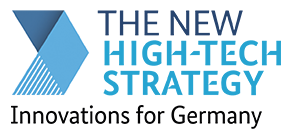 The High-Tech Strategy 2025 of the German Federal Government pursues the aim to advance Germany on its way to worldwide innovation leadership. Good ideas are to be quickly translated to innovative products and services, since the continuous search for innovative solutions is the driving force of our prosperity and our quality of life. They strengthen Germany’s position as a leading economic and exporting nation. And they render it possible to find creative answers to the pressing challenges of our times – be it sustainable urban development, environmentally friendly energy, individualised medicine, or digital society. The space sector plays an important strategic role for Germany as a business location. It is a trailblazer for developing and testing new technologies and – via technology transfer – inspires other business sectors. For this reason, the German Federal Government is funding space research in particular and banks on enhancing the competitiveness of German space flight. The national funding structures are correspondingly further developed. For encouraging spin-off (meaning transfer from space flight to other areas) and spin-in effects (meaning transfer from other areas to space flight), the INNOspace® initiative brings together space flight stakeholders and other industrial sectors in order to advance technology transfer.
The High-Tech Strategy 2025 of the German Federal Government pursues the aim to advance Germany on its way to worldwide innovation leadership. Good ideas are to be quickly translated to innovative products and services, since the continuous search for innovative solutions is the driving force of our prosperity and our quality of life. They strengthen Germany’s position as a leading economic and exporting nation. And they render it possible to find creative answers to the pressing challenges of our times – be it sustainable urban development, environmentally friendly energy, individualised medicine, or digital society. The space sector plays an important strategic role for Germany as a business location. It is a trailblazer for developing and testing new technologies and – via technology transfer – inspires other business sectors. For this reason, the German Federal Government is funding space research in particular and banks on enhancing the competitiveness of German space flight. The national funding structures are correspondingly further developed. For encouraging spin-off (meaning transfer from space flight to other areas) and spin-in effects (meaning transfer from other areas to space flight), the INNOspace® initiative brings together space flight stakeholders and other industrial sectors in order to advance technology transfer.
The six priority tasks for the future within the framework of the high-tech strategy ‒ for prosperity and quality of life
Health and care: for an active and self-determined life
How can we manage to cure diseases such as cancer more effectively? How can medical progress be made available to people faster? What contribution to more exact diagnoses and individual therapy is digitalisation supposed to make?
Examples for contributions by space flight: enhancement of fast telecommunication through satellite technology, utilisation of insights from space medicine (e.g., rehab), transfer of space technologies (e.g., image analysis algorithms for early diagnosis of cancer, or robotics for medical robots).
Sustainability, climate protection, and energy:
for the generations of today and tomorrow
Our mission: in industry, neutrality of greenhouse gases to the highest possible extent. To this end, a connection of the power, heat and traffic sectors is helpful to optimally use the fluctuating supply of renewable energies. A further issue in this context is sustainable economy by saving raw materials and preserving biodiversity.
Examples for contributions by space flight: research on better solar or wind technology plus energy storage. Further development of hydrogen systems and sector coupling of any kind of energy production for any purpose. Earth observation via the EnMAP satellite.
Mobility: for an intelligent and emission-free locomotion
The mobility of the future will be more sustainable and intelligently networked. The areas of vehicles, energy, and traffic are growing together – with the help of high-performance sensor technology and electronics, safe autonomous systems, as well as alternative propulsion systems and fuels.
Examples for contributions by space flight: in the H2ORIZON project (sector coupling of space flight, energy, and traffic at a megawatt scale), technologies are being developed and implemented for a complete hydrogen cycle – from the generation of hydrogen through wind energy to transport and storage through to use in fuel cells for mobility as well as power and heat supply and rocket tests. Additional examples: the initiative “Space Moves!” for fostering the transfer of space flight knowledge into the mobility sector. Enhancement of satellite navigation. Own institute for transport research at DLR. Lightweight construction from space flight.
Urban and rural areas: for an environment worth living and future-proof regions
How can we cope with the challenges presented by growing cities, but also by rural regions affected by out-migration and strong demographic change? With sustainable urban and rural development for sustainable living and industrial areas.
Examples for contributions by space flight: automation and thus cost reduction in the manufacture of components for residential houses by means of robotics from space flight. Electrically driven air taxis for the transport of passengers and goods. Autonomous vehicles to ensure more time flexibility for mobility in cities and rural areas.
Security: for an open and free society
Terrorism, organised crime, cyber crime, and natural disasters threaten our way of life, our quality of life, and our life. Civil security and IT security must be continuously fostered, extended and adapted to new threats.
Examples for contributions by space flight: Earth observation such as, for example, Copernicus for severe weather alerts and disaster management. The European satellite data relay system EDRS acts as the backbone of fast data transmission between various satellites and ground stations. The communication satellite Heinrich Hertz supports science and safety authorities.
Economy and work 4.0: for a strong economy and good work
Examples for contributions by space flight: relief of hard physical work through robotics.
